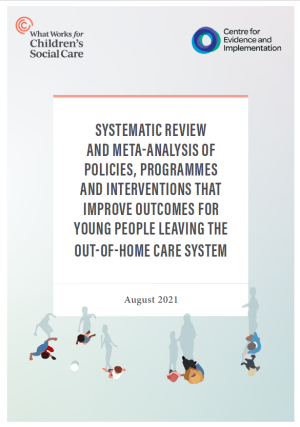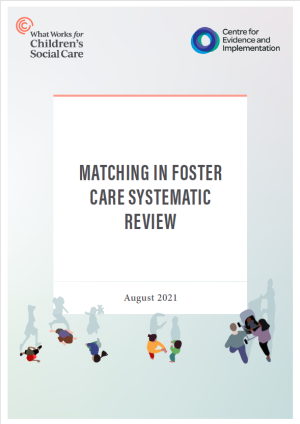Related
-

-

-
 Publication 1 Aug 2021
Publication 1 Aug 2021Systematic review: Improving 'matching' in foster care
-
 Insight 1 Feb 2022
Insight 1 Feb 2022Article: 'Matching in foster care and how we can improve it'
To help synthesise the evidence base about what kinds of services may work to improve health and wellbeing outcomes for young people leaving care, CEI undertook a systematic review and meta-analysis on behalf of What Works Children's Social Care that assessed the effectiveness of a diverse range of policies, programmes and interventions. CEI undertook the review with partners at Monash University, University of Bristol and The Fostering Network in the United Kingdom.
Young people who ‘age-out' of out-of-home care face increased risks of poor outcomes, including homelessness, unemployment and substance abuse. The types of support provided to these young people vary around the world, and debate continues about the optimal timing, type, frequency, intensity, combinations and ordering of services to support young people as they transition from care into independent living arrangements.
The review found limited but emerging evidence that extending care can improve outcomes across several domains. However, little is currently known about the best way to deliver this support; the research doesn't indicate which young people may need additional supports and in what combination they might be effective. Regarding other programmes or interventions, the review found that there is little evidence that, on their own, standard independent living services achieve positive outcomes, yet they continue to be financially supported in the United States. It may be the case that they are beneficial when combined with other support services, but they appear to be insufficient on their own. These findings do not necessarily mean this approach should be discarded, but without considerable improvement and pairing with other approaches it is unlikely to improve outcomes for young people.
Encouragingly, the review found that evidence base is growing. Research in this area is reaching a tipping point in terms of the number of rigorous studies available to enable more complex synthesis. Future syntheses would be aided by careful coordination of future studies. Additionally, more replication studies are needed for programs that demonstrate positive effect to increase the certainty of findings that can be used to test the core components of high-quality transition programs over time.
The full report is available here.
Study methods and findings:
Studies were included if they involved young people aged 16-25, who had been in out-of-home care due to concerns about child maltreatment and who were leaving care and entering independent living arrangements. Studies had either to have used random assignment to create treatment and control groups; or to have assessed outcomes for young people who received transition services compared to a statistically similar group of young people who did not.
Any policy, programme or intervention was eligible for inclusion if it targeted, and was provided to, young people leaving care or who had recently left out-of-home care.
The review authors found 25 eligible study reports, providing findings from 16 studies. Eight of the studies were randomised controlled trials. All but one study, which was from Australia, were conducted in the United States. The wide scope of the policies, programmes and interventions included in the review limited the capacity to statistically combine studies (otherwise known as meta-analysis). Still, we were able to conduct 19 small meta-analyses that encompassed both independent living programmes and coaching and peer support programmes. Only one of the 19 analyses reported a significant positive result, indicating that coaching and peer support programs have a medium sized impact on high school or equivalent completion. There were concerns about the risk of bias in both of the studies included in that analysis however, so certainty in this evidence is consequently low.
Most of the studies not included in the meta-analysis reported small or very small impacts, many of which were not significant. In all cases, there is considerable variation in effects between studies.
Our review of the evidence base contains key findings, implications, and the next steps in this area of research.



